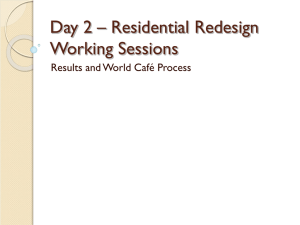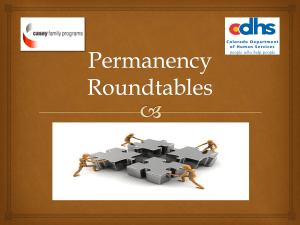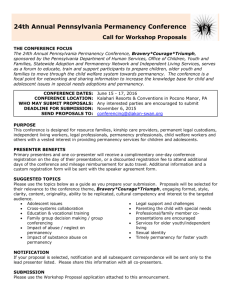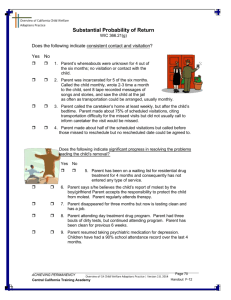Permanency Goal
advertisement
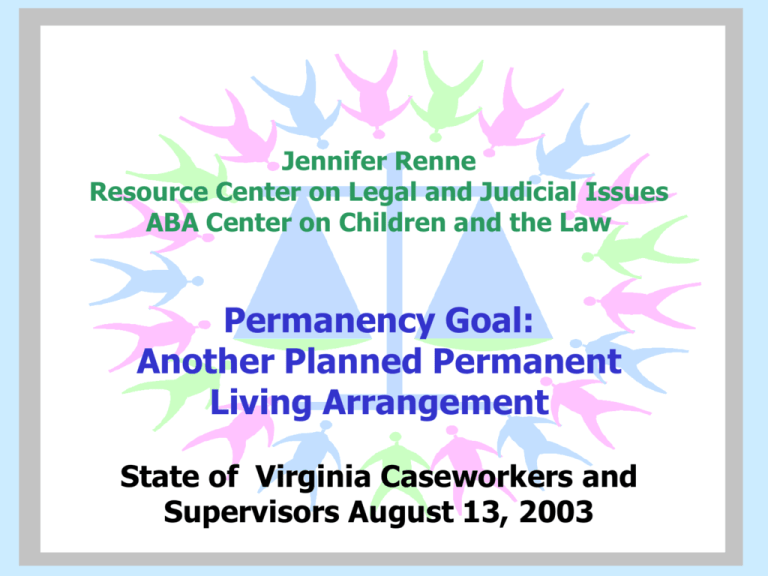
Jennifer Renne Resource Center on Legal and Judicial Issues ABA Center on Children and the Law Permanency Goal: Another Planned Permanent Living Arrangement State of Virginia Caseworkers and Supervisors August 13, 2003 Permanency Options Under ASFA Return to the Parent Adoption Legal Guardianship Permanent Placement with a Fit and Willing Relative Another Planned Permanent Living Arrangement (must document compelling reason) Compelling Reasons 2 different provisions: (1)The agency determines it has a “compelling reason” not to file a termination petition for child who has been in care “15 of the last 22 months” (2)“Compelling reason” why “another planned permanent living arrangement” is being selected as a permanency option Compelling Reasons Examples cited in regs: (1) an older teen who specifically requests that emancipation be established as his/her permanency plan; (2) the case of a parent and child who have a significant bond but the parent is unable to care for the child because of an emotional or physical disability and the child’s foster parents have committed to raising him/her to the age of majority and to facilitate visitation with the disabled parent; or (3) the Tribe has identified another planned permanent living arrangement for the child. 45 C.F.R. § 1356.21 (h)(3)(i), (ii), & (iii). Definition of Permanency A safe, nurturing and stable home environment and set of relationships Opportunity to live in a permanent home, one which can be returned to for support even as an adult Home intended to last indefinitely Family which gives a commitment to continuity for the child and allows for a lasting, supportive lifetime family relationship to be established Gives child a sense of belonging and a definitive legal and social status What is an “APPLA?” ASFA defines the term as “any permanent living arrangement not enumerated in the statute.” 42 U.S.C. 475(5)(C) “Planned” means the arrangement is intended, designed, considered, premeditated, or deliberate “Permanent” means enduring, lasting, or stable Includes: physical placement of the child quality of care supervision nurture What is an “APPLA?” Permanency goal for the child The objective is to craft the most stable, secure arrangement possible “Permanency” includes something more than merely meeting the child’s immediate physical, educational, social, and mental health needs Key to the child’s future happiness and success is the development of relationships with members of the child’s family and communities. Long Term Foster Care Group Care / Residential Treatment Independent Living Use of Long-Term Foster Care The statute struck the term “long-term foster care” The preamble to the regulations further explains “Far too many children are given the permanency goal of long-term foster care, which is not a permanent living situation for a child.” 65 Fed. Reg. 4036. LTF/C is not stable, may disrupt often, leading to frequent moves for the child and instability What about Group Care/Residential Treatment? Rarely is group care a living arrangement that is planned and permanent Consider group care a step towards achieving the child’s permanency plan of adoption, reunification, etc., not a goal. Group care should not be considered an APPLA if the child’s release from group care is reasonably likely during the child’s minority. Group care as an APPLA should require clear evidence that the young person will not be able to function in a family setting before reaching adulthood. What about Group Care/Residential Treatment? Factors to consider: Temporary versus permanent nature of group care Advocate or Guardian - Has the agency made attempts to locate/identify? - Does a close relationship exist? - Continue indefinitely? - Can paid staff ever qualify to perform that role? Are there designated contacts--relatives, for example, who provide respite care? What about Independent Living? Consider Independent Living a set of services, not a permanency goal. IL services should meet the child’s physical, psychological, emotional, educational needs Job Skills Safe Housing Connections to family, i.e. siblings Continuing education Peer connections Cultural identity Frame this as a “reasonable efforts” issue The agency should provide reasons why the living arrangement is expected to endure What services has the agency provided to: 1) meet needs of child? 2) ensure stability of placement? What support structures are being put in place? What efforts has the agency made to enhance the safety, quality, and stability of the APPLA? APPLA: Reasonable Efforts to Finalize the Permanency Plan Second required RE finding under ASFA Judicial finding - whether the agency provided reasonable efforts to finalize the permanency plan Within 12 months of the child’s entry into foster care & ever 12 months thereafter A negative, late, insufficient or missing finding means the agency is ineligible for IV-E dollars until the court makes a positive finding The finding must be detailed and child specific Reasonable Efforts Inquiry Have other permanency options been fully considered and ruled out for valid reasons? • Review compelling reasons at each and every permanency hearing and at each review to determine whether a more preferred permanency option is possible. What efforts has the agency made to identify and recruit a permanent placement for the child? • • • • Parents? Relatives? Current and former caretakers? Mentors, coaches, teachers, counselors, or employers? Have we asked the child? Is this placement the best way to meet child’s needs? Reasonable Efforts Inquiry Did the agency conduct a timely assessment and provide relevant services when the case first came in? • Permanency planning should begin when children are initially placed in out-of-home care • Sometimes the child is left in an arrangement that was originally intended as an emergency placement • Permanency planning becomes more complicated as the child becomes attached to the foster parents (what might have been a successful reunification case, or relative placement case, has now become an APPLA) • The agency’s reasonable efforts should include early assessment and planning to reduce the likelihood of a child being in a nonpermanent long-term arrangement by default instead of a more permanent one by design CONCURRENT PLANNING Reasonable Efforts to finalize an alternate permanency plan APPLA and : Reunification? Adoption? Relative Placement? Recommendations for Advocates and Courts Don’t use “APPLA” as a catchall for temporary plan Conduct an individual assessment of placement at each permanency hearing Review the youth’s service agreement Consider all issues pertaining to well being of child, including issues of visitation, with parents, siblings, others Recommendations for Advocates and Courts Ideally, the plan will involve a specific adult or couple (as opposed to an organization) certain powers and responsibilities playing permanent and important roles in the child’s life likely live with the young person, although not necessarily familial relationship with the child will continue beyond the life of the dependency case : Focus on building relationships between the child and those adults who will be a network of support for the child The court order should reflect that the arrangement is a permanent one, and should include all the elements that make it permanent. To Contact Us Jennifer Renne, 202-662-1731 Rennej@staff.abanet.org For training requests: Mimi Laver, 202-662-1736 Laverm@staff.abanet.org National Child Welfare RC on Legal and Judicial Issues ABA Center on Children and the Law 740 15th Street, NW Washington, DC 20005-1022

